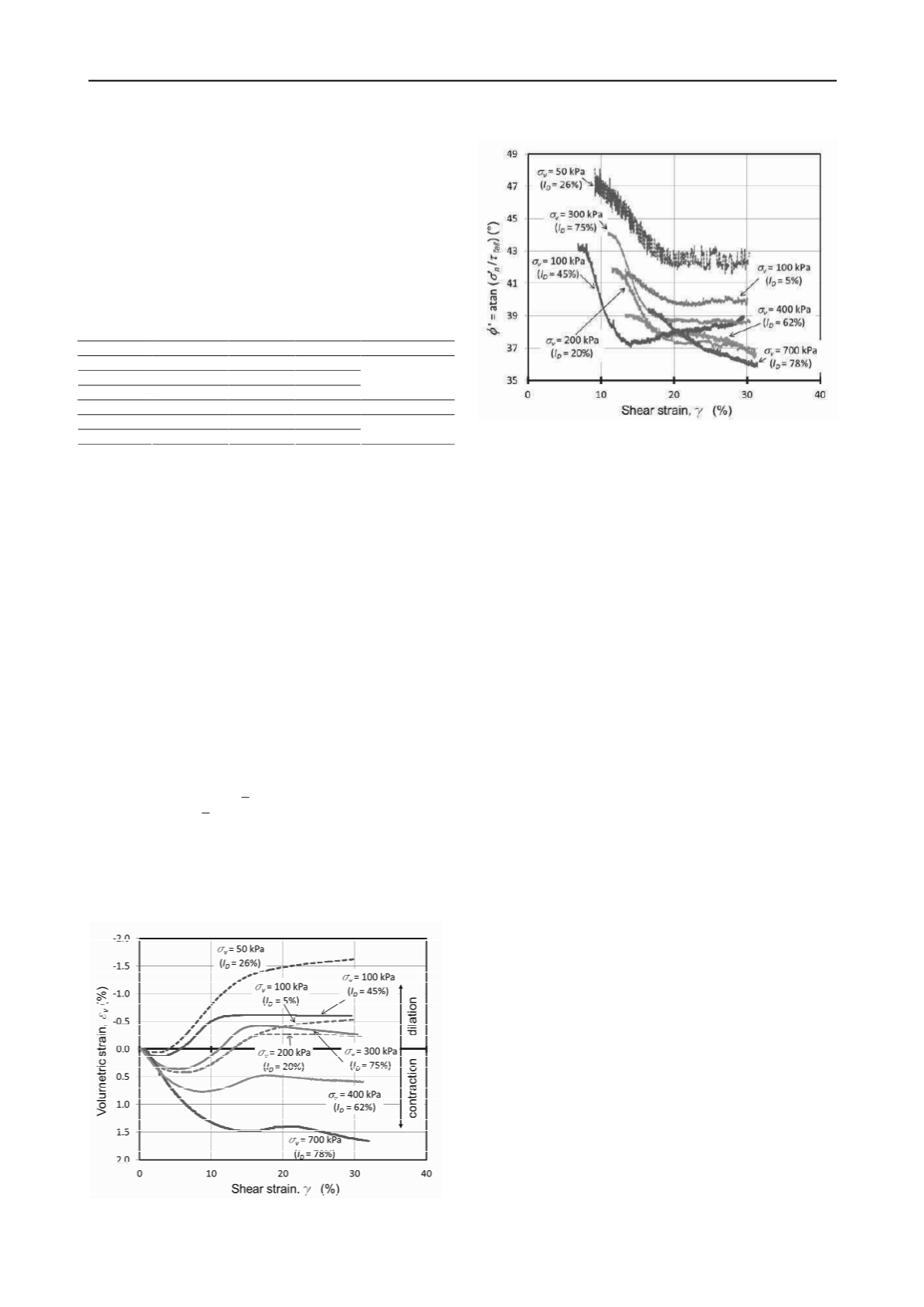
268
Proceedings of the 18
th
International Conference on Soil Mechanics and Geotechnical Engineering, Paris 2013
Proceedings of the 18
th
International Conference on Soil Mechanics and Geotechnical Engineering, Paris 2013
foundation punch-through failure depends on the operative
friction angle and associated dilation angle, both of which
reduce with increasing stress level.
This paper reports the results from a series of basic
characterisation tests conducted on reconstituted samples of
carbonate sand to understand its behaviour. Centrifuge tests
were also carried out on spudcan foundations penetrating four-
layer deposits, with an interbedded carbonate or silica sand
layer for direct comparison.
Table 1. Values of
Q
and
crit
derived from triaxial compression tests
(after Randolph et al. 2004, InSafeJIP 2010).
Sand
Mineralogy
Q
crit
Reference
Ticino
Siliceous
10.8
33.5
Toyoura
Quartz
9.8
32
Hokksund Siliceous
9.2
34
Jamiolkowski
et al. (2003)
Mol
Quartz
10
31.6
Yoon (1991)
Kenya
Calcareous 8.5
40.2
Quiou
Calcareous 7.5
41.7
Jamiolkowski
et al. (2003)
2 STRESS-STRAIN BEHAVIOR
Simple shear tests with a Berkeley type apparatus were
performed on uncemented skeletal carbonate sand recovered
from the seabed of Australian North-West Shelf (NWS).
Particles smaller than 75 μm and larger than 2.36 mm were
removed by washing and sieving prior to testing. The achieved
median grain size and coefficient of uniformity were
d
50
= 0.22
mm and
C
u
=
2.3, respectively. The high grain angularity and
intra-particle void resulted in a high void ratio with minimum
and maximum value of 0.91 and 1.36 respectively.
Drained tests with a lateral stress ratio
K
= 0.4 were
performed on loose and medium dense sand to obtain the stress-
strain behaviour. The results are shown in Figures 1 and 2,
highlighting a strong dependency of the volumetric dilatancy on
the confining stress. The values of relative densities (
I
D
) shown
in the figures represent the condition just before shearing.
Dilative volume change occurred even in loose sand at a vertical
stress
v
= 200 kPa (see Figure 1). This dilative response is not
unusual owing to the particle angularity and interlocking. For
most tests, shearing ended in dilative volume state, except two
at higher stresses with
v
> 400 kPa. Interestingly, for dense
sand subjected to
v
> 300 kPa, dilative response at intermediate
strains turned to contraction close to the end of shearing,
indicating the influence of continual particle breakage. A
transient dilation at the highest stress of
v
= 700 kPa was also
noticed at shear strain levels of 15 to 20%.
The transition from dilative to contractive behaviour
occurred at a lower stress level,
v
< 400 kPa or mean stress
p
< 240 kPa, compared to silica sand.
Figure 1. Volumetric change of carbonate sand in drained simple shear
test with lateral stress ratio
K
= 0.4.
Figure 2. Effective friction angle of carbonate sand in drained simple
shear test with lateral stress ratio
K
= 0.4 (post-peak condition only).
Peak dilation angle
peak
can be estimated using Bolton’s
(1986) empirical correlation
R
peak
crit
peak
mI
8.0
(1)
1
ln
p Q I
I
D R
(2)
where
m
is a constant, taken as 3 for failure under triaxial or
general loading conditions and 5 under plane-strain conditions,
and
I
R
is the relative dilatancy. Some reported values for
Q
for
siliceous grains range from 9.2 to 10.8, while lower values of
7.5 to 8.5 are reported for calcareous grains (see Table 1).
Assuming that the dilation angle of the NWS carbonate sand
turned to zero at a mean stress
p
= 240 kPa, a value for
Q
can
be calculated as 5.5.
The friction angle was interpreted using the AG method
(Joer et al. 2011) by considering the actual observed shear
plane. The normal and shear stresses were calculated for the
diagonal shear plane and used to determine the friction angle.
This method gave more realistic values compared to the
traditional interpretation, which assumes a complementary shear
stress on the vertical sample boundary. The calculated peak
friction angle
'
peak
ranges from 39.5° to 48°, while the residual
friction angles
'
res
from 35.8° to 42.9° (see Figure 2). No
uniform steady state can be identified, rather a tendency of
decreasing
'
res
with increasing confining stress is evident.
3 EFFECT OF PARTICLE DEGRADATION
In carbonate sands, high crushability and compressibility are led
by the high intra-particle porosity, as discussed previously.
Datta et al. (1980) reported the effect of grain crushing during
shearing and found direct correlations between crushing and
reduction of maximum principal effective stress ratio, change
from dilative to contractive behaviour, more plastic stress-strain
relation, and increase of failure strain.
Golightly and Hyde (1988) performed comprehensive
isotropic drained triaxial (CID) tests on three different skeletal
carbonate sands, all with a relative density of 97%. They
reported results in terms of friction angle
f
, calculating
according to
f
=
peak
-
, as shown in Figure 3. The dilation
angles of the tested carbonate sands were found lower than
those of the silica sand. The critical confining stress at which
dilation was suppressed was also shown to be very low
compared to silica sand. For instance, the dilation angle of Dogs
Bay sand, which is mainly composed of skeletal mollusc
fragments, decreased to zero at a confining stress of only 370
kPa. The siliceous Leighton Buzzard sand, on the other hand,
has a constant dilation angle of around 9° to 10° for all tested
confining stresses (< 1000 kPa).


